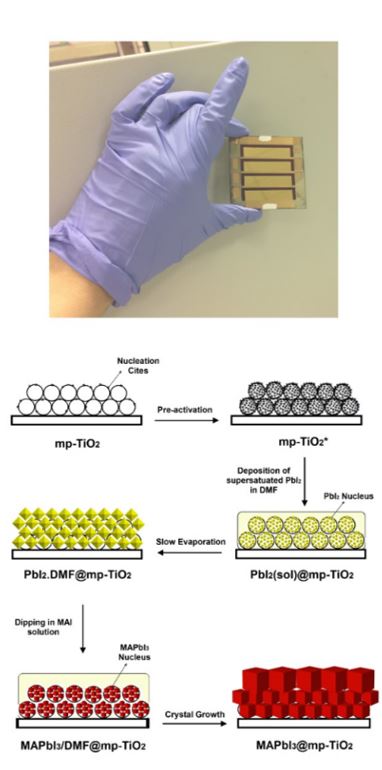
HIGHLY EFFICIENT PEROVSKITE SOLAR CELLS FOR LIGHT HARVESTING UNDER INDOOR ILLUMINATION VIA SOLUTION PROCESSED SNO2/MGO COMPOSITE ELECTRON TRANSPORT LAYERS
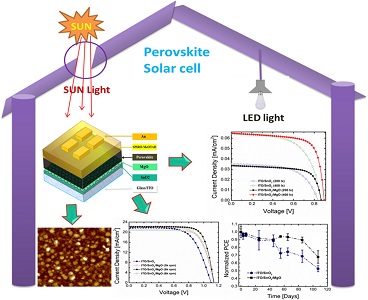
ABSTRACT
We present new architectures in CH3NH3PbI3 based planar perovskite solar cells incorporating solution processed SnO2/MgO composite electron transport layers that show the highest power outputs ever reported under typical 200–400 lx indoor illumination conditions. When measured under white OSRAM LED lamp (200, 400 lx), the maximum power density values were 20.2 µW/cm2 (estimated PCE = 25.0%) at 200 lx and 41.6 µW/cm2 (PCE = 26.9%) at 400 lx which correspond to a ∼ 20% increment compared to solar cells with a SnO2 layer only. The thin MgO overlayer leads to more uniform films, reduces interfacial carrier recombination, and leads to better stability. All layers of the cells, except for the two electrodes, are solution processed at low temperatures, thus low cost processing. Furthermore, ambient indoor conditions represent a milder environment compared to stringent outdoor conditions for a technology that is still looking for a commercial outlet also due to stability concerns. The unparalleled performance here demonstrated, paves the way for perovskite solar cells to contribute strongly to the powering of the indoor electronics of the future (e.g. smart autonomous indoor wireless sensor networks, internet of things etc).
Janardan Dagar, Sergio Castro-Hermosa, Giulia Lucarelli, Franco Cacialli, Thomas M. Brown
DOI: 10.1016/j.nanoen.2018.04.027
https://www.sciencedirect.com/science/article/pii/S221128551830257X
ON THE IMPORTANCE OF FERROELECTRIC DOMAINS FOR THE PERFORMANCE OF PEROVSKITE SOLAR CELLS
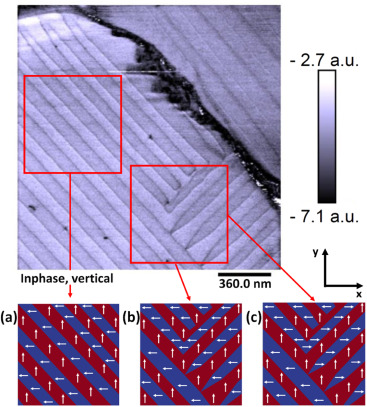
The effect of ferroelectric polarization patterns in MAPbI3 on JV characteristics has been analyzed. We discuss models for the polarization orientation pattern and magnitude of the ferroelectric domains. Simulations performed on real patterns show that the presence of ordered ferroelectric domains, even with a weak characteristic polarization magnitude enhances the power conversion efficiencies and are mandatory to reproduce the experimental J-V characteristics.
ABSTRACT
This work analyzes in detail the effect of ferroelectric polarization patterns in methylammonium lead iodide (MAPbI3) thin-films on the J-V characteristics of the corresponding solar cells. The simulations are based on a finite-element discretization of the drift-diffusion equations and take into account the polarization pattern experimentally derived from piezoresponse force micrographs. Based on the knowledge of the crystalline structure, symmetry considerations and electrical simulations, we discuss models for the polarization orientation pattern and magnitude of the ferroelectric domains. We conclude that the in-plane polarization vectors have 45° orientation towards the domain walls and form herring-bone structures. The presence of ordered ferroelectric domains, even with a weak characteristic polarization magnitude enhances the power conversion efficiencies and are mandatory to reproduce the experimental J-V characteristics.
Daniele Rossi, Alessandro Pecchia, Matthias Auf der Maur, Tobias Leonhard, Holger Röhm, Michael J. Hoffmann, Alexander Colsmann, Aldo Di Carlo
DOI: 10.1016/j.nanoen.2018.02.049
https://www.sciencedirect.com/science/article/pii/S2211285518301174
FULLY-SPRAYED FLEXIBLE POLYMER SOLAR CELLS WITH A CELLULOSE-GRAPHENE ELECTRODE
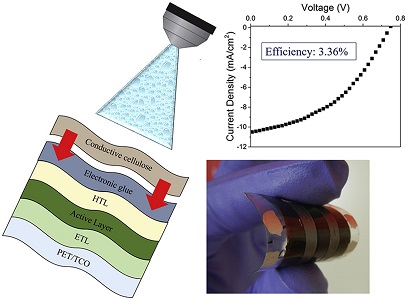
Light, flexible and low-cost organic solar cells made entirely by spray and with an innovative cellulose and graphene-based electrode!
The work, in collaboration with the Smart Materials group of the ISTITUTO ITALIANO DI TECNOLOGIA has been published on the important magazine "Materials Today Energy".
ABSTRACT
Organic photovoltaic (OPV) technology provides energy where conventional photovoltaics are difficult to implement. The rise of efficiency due to the introduction of new polymers and the definition of strategies for the scale-up push OPV devices towards large-scale manufacturing. Here, spray coating has been employed as an easy and versatile scalable technique to deposit all the layers of flexible polymer solar cells starting from PET/ITO/Ag/ITO substrates. A foldable nanocomposite based on cellulose and sprayed graphene nanoplatelets has been applied as top electrode through lamination. The overall fabrication process has been conducted in air by using commercial materials. A significant power conversion efficiency higher than 3% has been achieved and the high quality of the lamination process has been demonstrated by bending and adhesion tests. Such photovoltaic devices are the first fully-sprayed prototypes on plastic substrate and the novel structure has also been effective for devices with active area up to 0.75 cm2.
Luca La Notte, Pietro Cataldi, Luca Ceseracciu, Ilker S. Bayer, Athanassia Athanassiou, Sergio Marras, Enrica Villari, Francesca Brunetti, Andrea Reale
Materials Today Energy
January 2018
PEROVSKITE SOLAR CELLS ON PAPER AND THE ROLE OF SUBSTRATES AND ELECTRODES ON PERFORMANCE
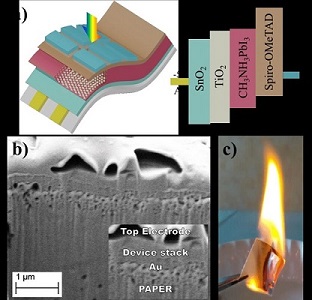
ABSTRACT
The first perovskite solar cell (PSC) fabricated directly on a paper substrate with a maximum power conversion efficiency of 2.7% is here reported. The paper PSCs (PPSC) were developed with a low-temperature Paper/Au/SnO2/meso-TiO2/CH3NH3PbI3/Spiro-OMeTAD/MoOx/Au/MoOx architecture utilizing a Au/SnO2 and MoOx/Au/MoOx stack as electron- and hole- extracting electrodes respectively. The transparent MoOx/Au/MoOx electrode had a favourable combination of transmittance (62.5%) and sheet resistance (9 Ω/□). By comparing performance of cells on paper with those fabricated on glass and plastic films with different electrodes, we identify avenues that can help guide future research for improved performance. All the deposition processes used are scalable and compatible with large area printing or evaporation technologies. Paper represents a lightweight, flexible, inexpensive, ubiquitous, and environmentally friendly material, paving the way for integrating perovskite technology with other electronic components as well as for the development of stand-alone PV devices on recyclable and low-cost paper substrates.
Sergio Alexis Castro Hermosa, Janardan Dagar, Andrea Marsella, Thomas M. Brown
IEEE Electron Device Letters
August 2017
DOI: 10.1109/LED.2017.2735178
A CRYSTAL ENGINEERING APPROACH FOR PEROVSKITE SOLAR CELLS AND MODULES FABRICATION OUT OF THE GLOVE BOX
ABSTRACT
In the present work we used some crystallization trends which could be classified as Crystal Engineering (CE) methods, for deposition of a pure cubic-phase thin film of CH3NH3PbI3 at the surface of mesoporous TiO2 layer. Accordingly, by using the CE approach in air, we fabricated high efficiency perovskite solar cells (PSC) and perovskite solar modules (PSM) utilizing several Hole Transport Layers (HTLs). The results show that the CE approach remarkably improved the device performance reaching a power conversion efficiency of 17%, 16.8% and 7% for spiro-OMeTAD, P3HT and HTL free, respectively. Furthermore, perovskite solar modules (active area of 10.1 cm2), could reach an overall efficiency of 13% and 12.1% by using spiro-OMeTAD and P3HT as HTLs, respectively. Sealed modules showed promising results in terms of stability maintaining 70% of the initial efficiency after 350 hours of light soaking at maximum power point.
N. Yaghoobi Nia, M. Zendehdel, F. Matteocci, L. Cinà, A. Di Carlo
J. Mat. Chem. A
6, 659-671
DOI: 10.1039/C7TA08038G
http://pubs.rsc.org/en/content/articlelanding/2018/ta/c7ta08038g#!divAbstract
PHOTOELECTROCHEMICAL AND SPECTROPHOTOMETRIC STUDIES ON DYE-SENSITIZED SOLAR CELLS (DSCS) AND STABLE MODULES (DSCMS) BASED ON NATURAL APOCAROTENOIDS PIGMENTS

ABSTRACT
We present a study on dye-sensitized solar cells (DSCs) and we fabricate dye-sensitized solar modules (DSCMs) based on natural apocarotenoids extracted from the achiote's seeds (annatto). Use of less polar solvent such as diethyl ether improves the bixin concentration in the annatto extract which, was employed as sensitizer in the devices. We measure IPCE max (∼33%) and estimate ϕinj≥0.438 for annatto. By accurate and progressive optimization of both TiO2 multilayer photoanode and of electrolyte composition an efficiency (η) around 1.6%, is achieved, with an improvement of about ∼742% compare to the best performance for annatto extract, so far reported. DSCM shows stability which overcomes 1000 h (shelf-life test), under 1 sun, and produces a battery capacity of ∼46.8 Ah, the equivalent to ∼15 type AAA standard battery, in a similar time period. Although annatto based DSCMs are still below the efficiency requirements for practical applications for large scale industry, our encouraging results, testify the potentiality of this pigment in the production of non-toxic, cheap, long term stable and environmentally friendly vegetable based solar devices, as alternatives to batteries for small electronic goods market.
Giuseppe Calogero, Jessica Barichello, Ilaria Citro, Paolo Mariani, Luigi Vesce, Antonino Bartolotta, Aldo Di Carlo, Gaetano Di Marco
Dyes and Pigments 155 (2018) 75-83
doi: 10.1016/j.dyepig.2018.03.021
PEROVSKITE MODULE
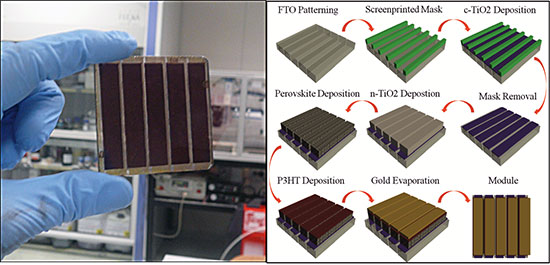
We fabricated the first perovskite-based monolithic series-type module showing very promising results in terms of the power conversion efficiency, the reproducibility of the fabrication process and long-term stability. To achieve these results, important innovative procedures were implemented in order to realize an efficient up-scaling process including:
- a customised formulation of TiO2 paste to realize a uniform thin titania scaffold by Screen Printing technique
- a proper cleaning procedure of the CH3NH3PbI3-xClx on the interconnection area between single cells to realize a patterned perovskite deposition
- a c-TiO2 patterned deposition
Furthermore, two different HTMs were used, i.e. the Spiro-OMeTAD and the P3HT polymer both reaching a PCE equal to 5.1%. The P3HT was utilized as cost-effective alternative material also to test the reproducibility of the fabrication process. These fabrication processes were here used for the first time to define a reproducible fabrication procedure applicable to large area. To achieve better performance in terms of PCE and long-term stability, future developments will concentrate on the study of efficient sealants, the optimisation of the perovskite deposition and the cleaning procedure of the interconnection area between neighbouring cells.
F. Matteocci, S. Razza, F. Di Giacomo, S. Casaluci, G. Mincuzzi, T. M. Brown, A. D'Epifanio, S. Licoccia and A. Di Carlo
"Solid-state solar modules based on mesoscopic organometal halide perovskite: a route towards the up-scaling process"
DOI: 10.1039/C3CP55313B

